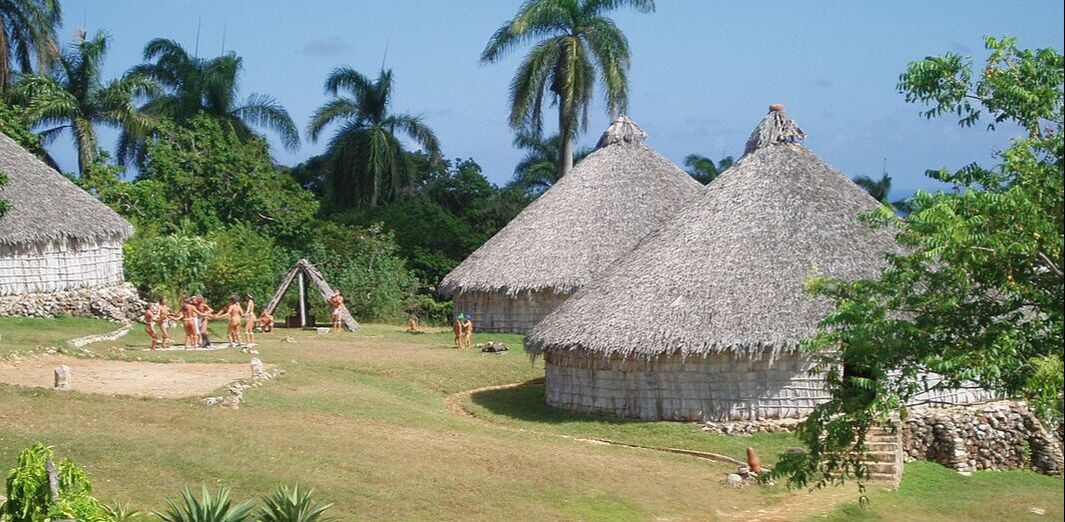|
The map above shows the Caribbean as it is today. Columbus spent the most time on an island called Haiti (though some think it was called Quizquella). He renamed it La Isla Española. When France took over the island it was called Santo Domingo (or Saint Domingue in French). Today the countries of Haiti and The Dominican Republic make up the island, now known as Hispaniola. before columbus The people who originally lived on the island we now know as Hispaniola were Taíno. As many as 750,000 Taíno were living on Hispaniola when Columbus first arrived. They lived on many of the islands in the Caribbean, but most historians agree that the largest population of Taíno were on Hispaniola. Other large populations were living on the islands of Cuba and Puerto Rico. A reconstruction of a Taíno village in Cuba. Taíno women were highly skilled in agriculture (growing food), while the men hunted and fished. They were skilled artisans making beautiful pottery, intricate belts woven from dyed cotton, and they carved incredible images from stone, wood, shell, and bone. Some of the first Spanish who met and wrote about them said they had well-organized communities with each village having a chief known as a cacique if it was a man or a cacica if it was a woman. Villages were then grouped into districts headed by one of the village cacique or cacica. These districts were then grouped into a region headed by the most prominent district cacique or cacica. This organizational structure is similar to the political structure of the United States with mayors, governors, senators, etc. It seems the Taíno were not used to battle or warfare because Columbus wrote, "They traded with us and gave us everything they had, with good will . . . they took great delight in pleasing us. They are very gentle and without knowledge of what is evil; nor do they murder or steal. Your highness may believe that in all the world there can be no better people . . . They love their neighbours as themselves, and they have the sweetest talk in the world, and are gentle and always laughing." He also wrote, "With 50 men you could subject everyone and make them do what you wished." He eventually did just that. Many of the words you know are from the Taíno language including hammock, hurricane, canoe, and tobacco. depopulation Columbus wrote of the Taíno people, “They will give all that they do possess for anything that is given to them, exchanging things even for bits of broken crockery. . . . They were very well built, with very handsome bodies and very good faces. . . . They do not carry arms [weapons] or know them. . . . They should be good servants.” He and his men enslaved Taíno men, women, and children and forced them to search for gold, build their settlements, and do any other task they wished. Failure to find gold or work as they expected was met with cruel and vicious punishment, and sometimes death. After finding very little gold on his second journey in 1493, and needing a cargo other than gold and spices to ship to Spain, Columbus decided to send the Taíno people he had enslaved as a show of the wealth available in the New World. He loaded the "best men and women" onto ships and sent them off to Europe. This was just the beginning of the widespread enslavement of the Native Peoples. Within thirty years, 80-90% of the Taíno population had died from disease, starvation, or brutal treatment. Baracutei Estevez, Jorge. "On Indigenous Peoples' Day, Meet the Survivors of a 'paper Genocide'." History. National Geographic, 04 May 2021. Web. 7 July 2022.
"Hispaniola." Wikipedia. Wikimedia Foundation, 04 May 2022. Web. 16 June 2022. Kmusser. "Caribbean General Map." Wikimedia Commons. Wikipedia Foundations, 9 Apr. 2011. Web. 17 June 2022. "Native Peoples-the "Indians"." Journey of Christopher Columbus. Glencoe/McGraw-Hill Publishing. Web. 16 June 2022. Poole, Robert M. "What Became of the Taíno?" Smithsonian.com. Smithsonian Institution, 01 Oct. 2011. Web. 16 June 2022. "Spanish Settlers Enslave the Taíno of Hispaniola - Timeline - Native Voices." U.S. National Library of Medicine. National Institutes of Health. Web. 17 June 2022. Comments are closed.
|
Author
I often struggle to find websites with thorough explanations in simple language to help kids understand historical events or scientific concepts, so I decided to create some of my own! -Cookie Davis
Archives
March 2024
|


 RSS Feed
RSS Feed